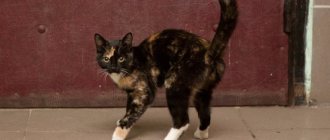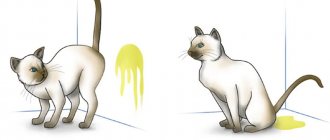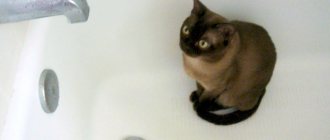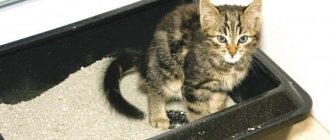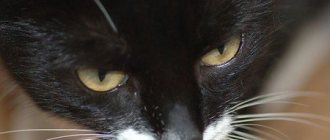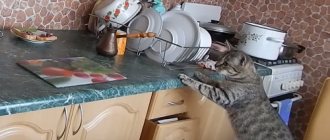Cats' partiality to flowers is a well-known and disappointing fact for plant lovers. But if the question of how to wean a cat that has made a toilet in a flower garden from shitting does not seem serious, then broken flower pots, an unpleasant smell and clods of earth on the floor make you think. Particularly violent pets completely destroy the flower, eating it at the root or throwing the pot off the windowsill. In this case, sooner or later, either there are no more flowers left in the house, or the owners are forced to get rid of the plants themselves. However, with due effort, it is possible to reach a compromise by maintaining the home garden and teaching the cat good manners.
Reasons and background
It is important to understand in time what is causing the pet’s behavior and whether it is related to discomfort when using the toilet. The reason why a cat does not go to the litter box may be due to its location, unsuitable substrate, dirt, unpleasant associations, or even illness. Therefore, if a cat suddenly pees in his favorite ficus, you should under no circumstances beat or punish him.
There is an opinion that a cat shits in flowers out of resentment or wanting revenge for lack of attention. If the pet is not played or communicated with much, this is how it seeks to express its dissatisfaction and “teach” the owner a lesson. This is unlikely to be the case, since a kitten taken from the street does not shit out of spite, but out of habit of relieving itself in the ground. In this case, the animal should be raised from a young age, accustoming it to a tray.
It will not be possible to wean a cat off with threats and exhortations alone. It is also important to determine the specific reason why your cat prefers a flower pot to a litter box. In addition to a simple whim, this could also be a health problem or an improperly equipped tray. The main thing is to identify and stop attempts at cat vandalism in time, otherwise the pet will acquire a bad habit, and in the worst case, the plants will die.
The kitten shits everywhere except the litter box
A kitten is a special case. When a kitten shits in the wrong place, this is a slightly different situation. Usually, babies are taught to use the litter box and many other things by their mother. But a cat is not always a good mother. Young, inexperienced cats can teach their kittens little, and sometimes even refuse to feed them breast milk.
Kittens quickly master the science of behavior in an apartment
If the cat has not done this, the breeder must accustom the kitten to the litter box. Babies grasp everything on the fly, and if they are regularly placed in a tray after eating and sleeping, the kittens quickly master this science and no longer shit anywhere. But sometimes the kitten is taken to another house when it is very young, or your apartment has too many rooms in which it is easy to get lost.
Having brought your baby to you, stay at home with him for the first few days. It is better to limit access to most rooms and put the kitten in the toilet as soon as he squeaks, shows anxiety, and immediately after he has eaten and slept. Two to three days will be enough for the cat to learn where he needs to relieve his needs.
Only if these rules are not followed can it happen that the baby will shit anywhere. After all, if you do not persistently show him where the toilet is, he will choose this place for himself, and maybe more than one.
What to do?
To prevent your pet from encroaching on the plants, it is better to hang them on a flower pot.
- Remove flowers from the animal’s reach: from window sills to high cabinets, shelves, flowerpots or in a separate room where the cat does not have access. If you have a personal plot, the pots can be taken outside, and in the warm season - to a closed balcony.
- Organize a mini-greenhouse, if possible. You can buy a glass box for small plants or make it yourself. This option is especially suitable for owners of succulents: in addition to the practical function, the florarium also has a decorative one.
- Keep the tray clean. You should clean as often as possible, preferably after each cat’s trip to the toilet. Many cats are squeamish, and once they go to the litter box, they will never defecate there again. If the cat refuses to relieve itself even in fresh substrate, replace the filler or try a different form of cuvette.
- Place several trays in different places. This will allow the animal to choose the most comfortable location, and will provide access to a clean tray in the event of a long absence of the owner.
- Keep an eye on your pet. Cats are prone to mischief in the absence of their owners, so if you notice that a cat is climbing into pots, you should splash water on it or scare it off with a sharp sound, for example, clap your hands, shout, and then take it to the litter box.
Plant protection
You can keep the animal away from the pots using toothpicks.
The substrate should be covered with a special net, thick cardboard, a plastic bottle cut in half, or the pot should be wrapped with double-sided tape. After several unsuccessful attempts to reach the ground, the pet will lose interest in plants. Pebbles or pine cones on the surface of the substrate will also help to keep the cat away from the plants. Sharp objects that are unpleasant for the paws will prevent you from climbing into the pot and rummaging in the ground. The pebbles should be quite large so that the cat does not dig them out of the pot along with the soil. Toothpicks or sticks firmly stuck into the ground are also suitable.
You can place lemon or orange peels in pots - cats are repelled by the smell of citrus fruits. In this case, only fresh, smelling zest is effective; dried zest will not do any good. Foil, rustling newspaper or waxed slippery paper spread around the flowers will prevent a timid cat from walking on the windowsill. It’s also worth purchasing a special bio-spray repeller “Antigadin” based on essential oils and spraying “forbidden” places. As a rule, 2-3 sprays per day are sufficient for a lasting effect.
Saving the carpet
The cat took revenge on one of the household members and made a puddle on his beloved and beautiful carpet. How to remove and how to get rid of this terrible smell? Let's try to save your carpet using the following methods:
- Laundry soap with glycerin. Thoroughly soap the stained area on the carpet, let it dry and rinse the carpet with clean water.
- Hydrogen peroxide, liquid soap and water. Pour into a spray bottle, apply to a dirty stain (pre-treated with soda), foam with a sponge, dry and vacuum away any remaining product.
- Glycerin is excellent at breaking down stone and is often used for both carpets and other surfaces.
- Soda with vinegar. Remove the fresh puddle, wipe dry and pour 3% (not 10%) vinegar over the contaminated area, let it dry, then sprinkle thoroughly with baking soda. Leave the product overnight and vacuum.
Eliminate odor
“Crime” can be easily determined by the unpleasant aroma, even if the cat visited the flowers only once. Since it is impossible to remove cat urine without vinegar or chemicals, the only way to get rid of the smell is to replace the substrate. Additionally, this is done so that the cat, not smelling the smell of urine, does not pee in the ground again. As a preventive measure, instead of store-bought medications, you can spray the pots with a homemade repeller made from water and a few drops of lavender, lemon or orange essential oils. So, the room will have a pleasant floral aroma.
Folk recipes
- White vinegar is a remedy that can eliminate even old odors. To prepare the solution, mix water and vinegar in a 1:1 ratio. Then you should wipe the urine with a regular rag and only then rub the prepared solution into the stain. Vinegar completely neutralizes the ammonia smell coming from urine. After some time, do not forget to wipe the treated area dry.
- Cleaner (enzymatic) . You should wash the urine dry and treat the area with a ready-made product. It contains special biological enzymes that quickly break down proteins in urine, thereby instantly eliminating unpleasant odor. An enzymatic cleaner can always be purchased at a specialty store. The product is great for removing odors from upholstered furniture and bed linen.
- Apple cider vinegar should be mixed equally with regular laundry detergent, applied to the dirty area, rubbed in thoroughly and left to act for several minutes. After this, remove the product with a regular rag.
- Bleach (no ammonia) . Wash the contaminated area with a regular cleaning agent and remove with clean water, wipe dry and treat with the prepared composition: mix water and bleach (1:10), pour into a spray bottle. Use the product very carefully, since the chlorine contained in it can ruin the color and surface structure.
- Iodine . Prepare a solution: stir 10 drops of iodine in 1 liter. water, then use it to treat the contaminated surface, leave for 10 minutes and wipe dry.
- Soda . Sprinkle the surface with regular baking soda. This natural product perfectly absorbs any odors. If the contaminated area is small, just rub soda into it with a sponge and leave for several hours, vacuum and wash with water.
- Squeeze the juice from the lemon, apply it to a cloth and gently clean the dirty area.
- Mix dishwashing liquid (2 tsp) with 0.5 tbsp. hydrogen peroxide. Apply it to the contaminated area (previously sprinkled with soda). Rub the solution thoroughly until foam is obtained, then allow to dry, vacuum and remove any remaining product with clean water.
- Mouthwash . First, remove the urine and wipe the surface dry, apply rinse aid to the stain, let it dry, repeat the procedure.
- Potassium permanganate is a strong oxidizing agent and an excellent deodorizing agent. Prepare a weak solution and treat the contaminated area with it, let it dry. Repeat cleaning (washing) several times until the cat smell disappears completely.
Among the most effective folk remedies are sleeping tea and Lenore.
Flower restoration
In addition to such dirty tricks, your pet can also knock over pots of plants.
For many owners, the peaceful coexistence of indoor plants and a cat in the same house is a rare success. Even if the pet does not pee in the flowers, it bites off leaves and shoots, scatters soil and knocks over pots. This is fraught not only with the death of flowers, constant chaos in the apartment, spoiled mood, but also poisoning the animal with poisonous juices.
The best way to solve a problem is to prevent it from happening. As soon as the owner discovers the pet’s destructive tendencies, it is worth taking immediate action to protect the plants from his encroachments.
First aid is to isolate and replant the flowers; those especially affected are placed in a home greenhouse. If it is not possible to remove large tubs from the “risk zone,” close the substrate and wrap the plant trunk with dense material, after spraying it with cat repellent. A cat will be distracted by having her own garden made specially for her from vitamin-rich grass, which you can buy at a pet store or grow yourself - such a maneuver will not only protect the plants from unwanted attention, but will also supplement the pet’s diet with healthy greens.
How to stop a cat from crapping in the apartment yourself
Use the following simple tips to correct the situation when your cat shits:
- Experienced owners who have raised more than one cat claim that it will never defecate where it eats food. If you find a place where a cat or kitten regularly poops, place a bowl of food there, or scatter food nearby on a piece of paper.
- Some people suggest scaring the animal. As soon as you catch your cat doing something bad, spray him with water from your hand or from a spray bottle. The fear he has experienced will discourage him from crap in this place. You can also knock loudly nearby with a rolled-up newspaper.
- Give the animal more attention. Perhaps the cat is simply bored without you or is experiencing stress from the appearance of a small child or another animal in the house. Your task is to create a feeling of comfort and safety for him, then the cat will not urinate on your carpet and on your things.
It is useless to poke the animal’s nose into its piles or puddles; this will not help wean the cat from a bad habit. Cats do not tolerate violence and instead of the desired effect, you risk getting the opposite result. Your pet may forever lose trust in you and become angry, but he is unlikely to understand his guilt.
Special means
“Zoosan” is a particularly popular product among consumers due to its affordable cost and practicality, and it is odorless.- “Odor Gone” is an aerosol that is absolutely safe for both animals and humans, consisting of natural ingredients.
- "Bio-GM" is a natural remedy that can completely eliminate odor, and not just mask it.
We create negative associations in a cat after going to the toilet in flowers (psychological methods)
If you notice a kitten perched in a potty with the intention of peeing, spray water in the face from a spray bottle or lightly spank it with a wet rag. It is important to do this at the very moment of action, so that the unpleasantness is clearly associated with the bad deed. Otherwise, this will be perceived as a demonstration of the owner’s superiority and will wean him from repeating dirty tricks:
- in an adult cat, delayed punishment will cause aggression;
- the little one will become afraid of the owner.
Damage to flowers, as defense of one's territory, stress, illness or lack of attention, is simply regarded by the cat as a bad habit. If you immediately figure out the reason for such strange behavior and stop your cat from shitting in the potty, you can avoid more serious problems in the future.
We have such a scoundrel who decided to try going to a flower pot instead of a tray. I suspect he did this a couple of times. Hibiscus flower, large and lush. Is it necessary to replace the soil? You need a lot of it, and the season is not right. What to do with the flower? Have you already “sorted things out” with the cat?
Author of the publication
Do not worry! Nothing will happen to the hibiscus. I have experience in this case. There is no need to change the soil in the pot. Consider that your indoor plant has received its “portion” of fertilizer. My cat is also partial to flowers, especially bulbous ones. I don’t know how my hippeastrum holds up. The cat also “looked” there several times. But he destroyed the orchid that was given to me for my birthday the next day. I came home from work, and there was a pathetic half of an onion sticking out in the flower pot. Ate it! And there was nothing left of the flowers and leaves. So there are other miracles here.
Protecting the soil from being torn up by cats
Cats are often attracted not so much to the plants themselves as to the soil in the pots. Digging in the ground for sanitary purposes or for fun is a great pleasure. But any such tearing turns into disaster for the plants themselves and everything that surrounds them. Large pots and tubs are especially attractive to fluffy ones. It is believed that cats picked up from the street most often undermine the ground, but this is rather a theory and a question of the quality of the cat’s training.
There are several ways to deal with the problem of soil tearing:
- use heavy or dense mulching materials - cones, large shells, heavy stones or coarse gravel;
- combine decorative mulching with repellent odors;
- cover the soil surface with a metal or plastic mesh;
- use special protective grilles.
Adhesive tape
According to their instincts, cats do not like sticky surfaces. Just like foil, a strip of adhesive tape should be applied in a thin layer on top of the ground. The cat obviously won’t like the fact that his paws are stuck, and he definitely won’t want to repeat the attempt to crawl into the flower a second time.
When watering, you will also need to lift the tape. This option is not suitable only if the pet likes to chew bags. This method can harm his health and will have to be abandoned.
Proper organization of plant collection
Proper placement of indoor plants that attract cats is the main means of combating overeating, soil undermining, and other cat pests. It is necessary to organize the coexistence of domestic plants and animals so that contacts are reduced to a minimum in a natural way.
The simplest option is to place the plants that the cat loves higher up, in hard-to-reach places - but it is also the most controversial. Firstly, hard-to-reach places or high placements are not always unattainable for cats, which can climb to any height and overcome any obstacles. Secondly, not every place will be comfortable for the plant itself - both in terms of lighting level and access to fresh air or temperatures.
But there are several rules for plant placement that will help minimize potential harm:
- It is better to place indoor plants on the walls or hanging;
- you need to choose heavy, stable containers for plants that are not easy to turn over even for an adult cat;
- It is better to prefer alternative options to placement on the windowsill, and if this is not possible, organize the collection so that there is more free space on the windowsill (some of the plants can be placed on racks or hung as ampels);
- Any racks and stands need to be additionally secured so that they are not only reliable, but also stable.
If your cat particularly likes some plants, it is worth choosing more reliable methods, taking into account all the disadvantages of conventional methods. True, the options for protecting plants from among cat's favorites are quite limited:
